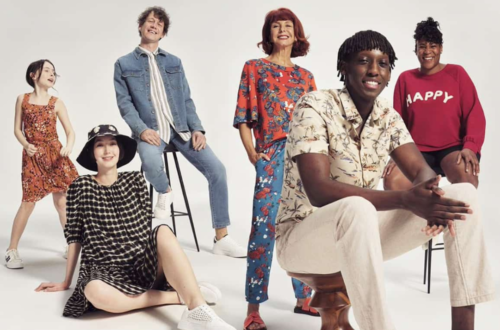Transformative Influence: Technology and Innovation in the Fashion Industry
The fusion of technology and innovation in the fashion industry has become a driving force behind transformative change, reshaping how we conceive, create, and consume fashion. From immersive virtual reality experiences to sustainable materials and data-driven design methodologies, these advancements are redefining the very essence of fashion. This synergy, encapsulated by the phrase “technology and innovation in the fashion industry,” underscores the industry’s commitment to pushing boundaries, fostering creativity, and addressing pressing sustainability challenges. As we navigate this ever-evolving landscape, one thing remains clear: technology will continue to serve as a catalyst for innovation, driving fashion towards a more inclusive, sustainable, and technologically-empowered future.
The fashion industry has always been synonymous with creativity and self-expression. However, in recent years, technology and innovation have emerged as powerful forces that are reshaping the landscape of fashion. From virtual reality runways to smart fabrics, these advancements are revolutionizing the way fashion is designed, produced, and consumed. In this blog, we will explore the impact of technology and innovation on the fashion industry and delve into the upcoming trends that are set to redefine the future of fashion.
Digital Fashion and Virtual Reality
One of the most significant influences of technology on the fashion industry is the rise of digital fashion and virtual reality experiences. Fashion brands are now embracing digital platforms and creating virtual showrooms and runways that allow consumers to experience fashion in a whole new way. Through virtual reality (VR), fashion shows can be accessed by anyone around the globe, transcending the limitations of physical space and increasing inclusivity. This technology also enables designers to experiment with new concepts, pushing the boundaries of creativity and presentation.
Sustainable Fashion and Material Innovations
In an era of increasing environmental awareness, sustainable fashion has become a paramount concern for both brands and consumers. Technology and innovation are playing a crucial role in driving sustainability in the fashion industry. From the development of eco-friendly materials to advancements in recycling and upcycling techniques, fashion is embracing a more responsible approach. Innovations such as biodegradable fabrics, 3D printing of garments, and the use of recycled materials are paving the way for a more sustainable future in fashion.
Smart Fabrics and Wearable Technology
The fusion of fashion and technology has given rise to smart fabrics and wearable technology, which are set to revolutionize the way we interact with our clothing. Smart fabrics incorporate embedded sensors, microchips, and conductive threads that enable various functionalities. From garments that monitor health parameters to clothing that adapts to changing weather conditions, wearable technology is enhancing the functionality and convenience of fashion. These innovations are not only transforming everyday clothing but also creating new opportunities for performance wear, sports apparel, and even medical textiles.
Data-driven Design and Personalization
The fashion industry is harnessing the power of data and analytics to inform design decisions and create personalized experiences for consumers. With the advent of artificial intelligence (AI) and machine learning, brands can analyze vast amounts of data, including customer preferences, shopping habits, and social media trends. This data-driven approach enables fashion companies to tailor their offerings to individual consumers, providing personalized recommendations and curated collections. From virtual stylists to customized sizing solutions, technology is enabling fashion to become more personalized and customer-centric.
Augmented Reality and Virtual Fitting
Trying on clothes virtually has become a reality with the advent of augmented reality (AR) and virtual fitting technology. AR applications allow consumers to visualize how garments would look on them without physically trying them on. Virtual fitting rooms provide a convenient and immersive shopping experience, allowing users to virtually try on different sizes, colors, and styles. This technology not only saves time and reduces the hassle of returns but also enhances the online shopping experience by bridging the gap between the digital and physical worlds.
Supply Chain Transparency and Blockchain
Technology is also addressing the need for greater transparency and traceability in the fashion supply chain. Blockchain, a decentralized and secure digital ledger, is being utilized to create transparent and immutable records of the entire production process, from raw materials to finished garments. This technology ensures that consumers can trace the origins of their clothing, promoting ethical practices and reducing the environmental impact of fashion.
Social Media and Influencer Culture
The rise of social media platforms has had a profound impact on the fashion industry, transforming the way brands market and sell their products. Social media influencers have become powerful voices, shaping trends and influencing consumer purchasing decisions. Fashion brands leverage social media platforms to engage with their audience, build brand awareness, and generate buzz around their products. Additionally, platforms like Instagram and Pinterest serve as sources of inspiration, enabling users to discover new styles, designers, and fashion trends.
3D Printing in Fashion
3D printing technology is making waves in the fashion industry, offering new possibilities for design, customization, and production. Designers can create intricate and complex structures that were previously impossible to achieve using traditional manufacturing methods. 3D printing allows for rapid prototyping and the ability to produce garments on-demand, reducing waste and minimizing the need for inventory. This technology opens up avenues for innovative and avant-garde designs while also enabling more sustainable practices in fashion production.
Robotics and Automation
Automation and robotics are increasingly being integrated into various aspects of the fashion industry, from garment production to warehousing and logistics. Automated machines and robots can streamline processes, improve efficiency, and reduce labor-intensive tasks. This technology not only speeds up production but also ensures consistent quality and precision in garment manufacturing. By automating repetitive tasks, fashion brands can free up human resources to focus on more creative and value-added activities.
The Rise of Fashion Tech Startups
The convergence of fashion and technology has given rise to a new wave of fashion tech startups. These innovative companies are exploring cutting-edge technologies and disrupting traditional fashion practices. Whether it’s developing sustainable materials, creating virtual fashion experiences, or inventing new ways to personalize clothing, fashion tech startups are driving the industry forward with their fresh ideas and entrepreneurial spirit.
Some Demographic Statistics Related to the Fashion Industry
Gender Preferences
Fashion preferences can vary between genders. According to a survey by Statista, women accounted for approximately 60% of global apparel and footwear sales, while men accounted for the remaining 40%. However, it’s important to note that these preferences can vary across regions and age groups.
Age Groups
Fashion preferences can differ significantly among various age groups. For instance, younger consumers, such as millennials and Gen Z, are often seen as trendsetters and early adopters of new fashion styles. On the other hand, older consumers may prefer more classic and timeless fashion choices. Understanding the preferences of different age groups is crucial for fashion brands to effectively target their desired audience.
Geographical Variations
Fashion trends and preferences can vary across different regions and countries. Factors such as cultural influences, climate, and socio-economic conditions can impact fashion choices. For example, countries with warmer climates may have a higher demand for lightweight and breathable fabrics, while colder regions may favor warmer and more insulated clothing.
Income Levels
Income levels play a significant role in fashion consumption patterns. Higher-income individuals may have a greater disposable income to spend on luxury and designer brands, while those with lower incomes may opt for more affordable fashion options. Understanding the income distribution of the target market is essential for fashion brands to align their pricing strategies and product offerings.
Fashion Influencers and Social Media
Social media platforms have become influential in shaping fashion trends and consumer behavior. Fashion influencers, bloggers, and celebrities on platforms like Instagram, YouTube, and TikTok play a crucial role in driving consumer preferences. The demographics of the influencer’s audience can provide insights into the target market and help fashion brands tailor their marketing strategies accordingly.
Online Shopping Behavior
The rise of e-commerce has transformed the way consumers shop for fashion. Demographic factors such as age, income, and geographic location can influence online shopping behavior. For example, younger consumers tend to be more comfortable with online shopping, while older consumers may prefer in-store experiences. Understanding the demographics of online shoppers is vital for fashion brands to optimize their online platforms and provide a seamless shopping experience.
Ethical and Sustainable Consumer Behavior
There is a growing consumer demand for sustainable and ethically produced fashion. Demographics such as age, education level, and income can influence the importance placed on sustainability in fashion choices. Younger consumers and those with higher education tend to be more aware and conscious of ethical fashion practices. Understanding the demographics of environmentally conscious consumers can help fashion brands align their sustainability initiatives and marketing strategies.
These demographic statistics provide insights into the diverse preferences and behaviors of fashion consumers. By understanding the demographics of their target market, fashion brands can develop tailored strategies, create relevant products, and deliver engaging experiences that resonate with their audience.
Technology and innovation have become catalysts for change in the fashion industry, shaping the future of fashion in exciting and transformative ways. From virtual reality experiences to sustainable materials, smart fabrics to data-driven design, these advancements are revolutionizing the entire fashion ecosystem. As technology continues to evolve, we can expect even more groundbreaking innovations that will redefine the way we create, consume, and interact with fashion.
How is virtual reality (VR) changing the fashion industry?
Virtual Reality (VR) is revolutionizing the fashion industry by providing immersive and engaging experiences for both designers and consumers. In the realm of design, VR allows designers to create virtual prototypes and visualize their creations in a three-dimensional space before they’re physically produced. This enables faster iteration, more accurate visualization of how garments will drape and move, and reduced waste. For consumers, VR is transforming the shopping experience by offering virtual showrooms and runways, accessible from anywhere in the world. Shoppers can virtually “walk” through stores, interact with products, and even try on clothing using avatars, enhancing convenience and accessibility. VR fashion shows offer a front-row seat to anyone, regardless of location, democratizing access to high fashion and potentially expanding brand reach. Additionally, VR can be used for training staff on new collections and merchandising, and for creating engaging marketing campaigns that transport consumers to virtual fashion worlds.
What are some examples of sustainable materials being used in fashion?
Sustainable materials are gaining significant traction in the fashion industry as brands and consumers seek eco-friendly alternatives. Innovations in this space include:
- Recycled Fabrics: Materials like recycled polyester, nylon, and cotton are being used to create new garments, reducing waste and minimizing the demand for virgin resources.
- Organic Cotton: Grown without harmful pesticides and fertilizers, organic cotton offers a more sustainable option for cotton-based products.
- Tencel™ Lyocell: Derived from sustainably harvested wood pulp, Tencel™ is known for its softness, breathability, and biodegradability.
- Piñatex: A leather alternative made from pineapple leaf fibers, Piñatex offers a cruelty-free and sustainable option.
- Econyl®: Regenerated nylon made from discarded fishing nets and other nylon waste, Econyl® reduces ocean pollution and promotes a circular economy.
- Mushroom Leather: Made from mycelium, the root structure of mushrooms, this innovative material offers a vegan and sustainable alternative to traditional leather.
These are just a few examples of the many sustainable materials being explored and adopted by the fashion industry, signaling a shift towards a more eco-conscious approach to production.
What is wearable technology, and how is it being incorporated into clothing?
Wearable technology refers to smart garments and accessories that incorporate electronic components, sensors, or microchips to provide enhanced functionality beyond traditional clothing. This emerging field is revolutionizing the way we interact with our garments and blurring the lines between fashion and technology. Some examples include:
- Fitness Trackers: Embedded in clothing or accessories, these track physical activity, heart rate, and other health metrics.
- Smartwatches: Offer a range of functions beyond timekeeping, including fitness tracking, communication, and mobile payments.
- Heated Clothing: Jackets and other garments with built-in heating elements for warmth in cold weather.
- GPS Clothing: Incorporates GPS technology to track location and provide navigation.
- Illuminated Clothing: Features light-emitting elements for safety or aesthetic purposes.
- Biometric Clothing: Monitors vital signs like heart rate and body temperature.
The possibilities of wearable technology are vast, with ongoing research and development pushing the boundaries of what clothing can do.
How does data analytics influence fashion design and trends?
Data analytics plays a pivotal role in shaping fashion design and predicting trends. By analyzing vast amounts of data from various sources, including social media, online sales, and consumer surveys, fashion brands gain valuable insights into customer preferences, purchasing behavior, and emerging trends. This information can be used to inform design decisions, create targeted marketing campaigns, and tailor product offerings to specific demographics.
Artificial intelligence (AI) and machine learning algorithms further enhance data analytics capabilities, allowing brands to identify patterns and correlations that might not be apparent to the human eye. This can help designers anticipate upcoming trends, optimize inventory management, and create personalized recommendations for customers. Additionally, data-driven design tools enable designers to test various design options virtually before committing to production, streamlining the design process and reducing waste.
What are the benefits of virtual fitting rooms for consumers and retailers?
Virtual fitting rooms, powered by augmented reality (AR) and virtual try-on technology, offer numerous benefits for both consumers and retailers. For consumers, virtual fitting rooms provide a convenient and risk-free way to try on clothing and accessories from the comfort of their own homes. This can reduce the need for physical store visits, save time, and minimize the hassle of returns. Virtual try-on technology allows customers to visualize how garments would look on them in different sizes, colors, and styles, enhancing the online shopping experience and increasing confidence in purchasing decisions.
For retailers, virtual fitting rooms can improve customer engagement, reduce return rates, and increase sales. By offering a more immersive and personalized shopping experience, retailers can attract and retain customers. The data collected from virtual try-on sessions can also be used to gain valuable insights into customer preferences, inform inventory management, and optimize product offerings.
How is blockchain technology improving transparency in the fashion supply chain?
Blockchain technology is revolutionizing transparency and traceability in the fashion supply chain by creating an immutable and decentralized ledger that records every step of the production process, from raw materials to finished products. This enables brands and consumers to trace the origins of garments, verify authenticity, and ensure ethical and sustainable practices are followed.
By providing a transparent and auditable record, blockchain can help combat counterfeit goods, reduce fraud, and empower consumers to make more informed purchasing decisions. It can also incentivize brands to adopt sustainable and ethical practices, as consumers can easily verify the claims made about a product’s origin and production methods.
What are some examples of innovative fashion tech startups and their contributions?
The fashion-tech landscape is brimming with innovative startups that are reshaping the industry through cutting-edge technology:
- Unspun: This company uses 3D body scanning and on-demand manufacturing to create custom-fit jeans, reducing waste and promoting individuality.
- The Fabricant: A digital fashion house that creates virtual clothing and accessories for avatars and digital platforms, challenging the traditional concept of physical garments.
- Bolt Threads: This biotech company develops innovative materials like spider silk-inspired proteins and mushroom leather, offering sustainable alternatives to traditional textiles.
- Wearable X: Creates smart clothing that integrates technology to enhance physical performance and well-being, blurring the lines between fashion and function.
- Thread International: Translates plastic waste into high-quality fabrics, promoting a circular economy and reducing environmental impact.
- Stitch Fix: Employs AI and data analytics to curate personalized clothing recommendations for customers, revolutionizing the online shopping experience.
These startups, along with countless others, are at the forefront of technological innovation in fashion. They are pioneering new materials, sustainable practices, personalized experiences, and digital solutions that are transforming the way we design, produce, consume, and interact with fashion. Their contributions are not only shaping current trends but also paving the way for a more inclusive, responsible, and technologically advanced future for the fashion industry.






